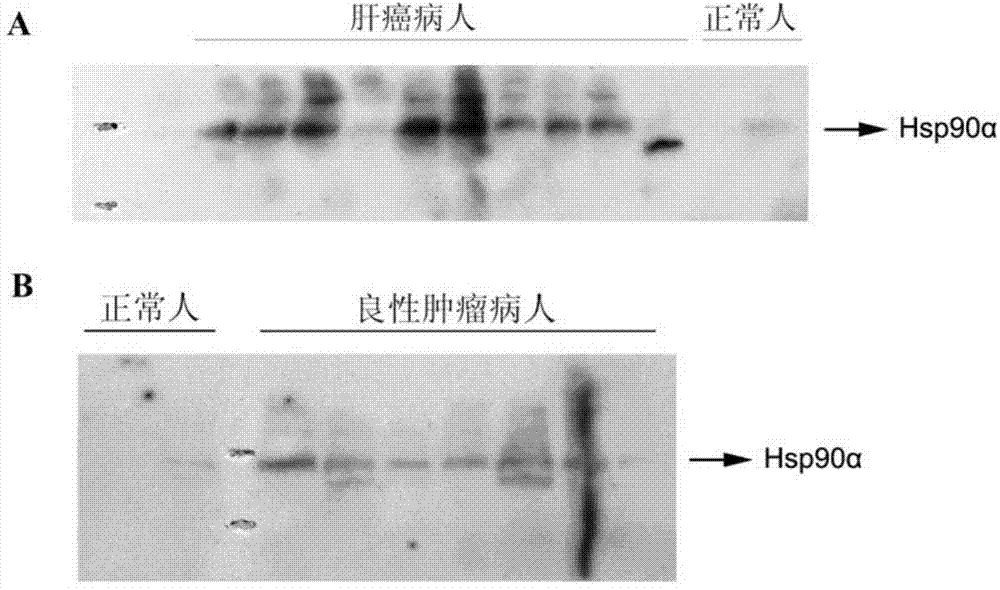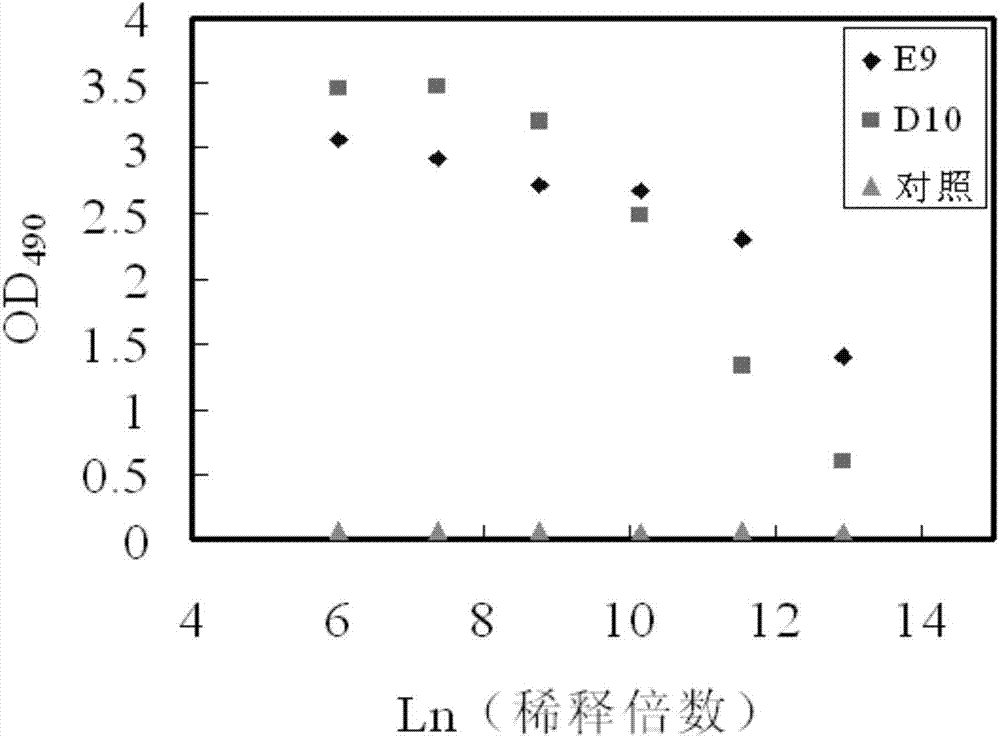New tumor marker
A technology of tumors and conjugates, which is applied in the field of tumor treatment and tumor metastasis, and can solve the problems of not mentioning the correlation of tumor metastasis, not defining the normal and abnormal content range, and not identifying the existence form of Hsp90α
- Summary
- Abstract
- Description
- Claims
- Application Information
AI Technical Summary
Problems solved by technology
Method used
Image
Examples
Embodiment 1
[0113] Example 1: Collection and preparation of mouse plasma samples, and detection of plasma Hsp90α
[0114] Balb / c mice with an average body weight of about 20 grams (purchased from Beijing Weitong Lihua Laboratory Animal Technology Co., Ltd.) were selected and randomly divided into two groups with 3 mice in each group, one of which was implanted with H22 mouse liver cancer cells in the armpit. (CCTCC, ID: GDC091) 10 cells per access 6 A control group was not inoculated with tumors. When the tumor diameter of the mice grew to an average of 2 cm (about 20 days), blood was collected from the fundus venous plexus, and anticoagulants were added to the blood to avoid hemolysis. Samples were recollected if hemolysis occurred. The whole blood was collected and centrifuged twice at 6000g at 4°C. The supernatant was collected, and the content of Hsp90α in the plasma was detected by western blotting. The antibody was Rabbit anti-human Hsp90αpAb (Labvasion). The BCA method (Pierce) ...
Embodiment 2
[0115] Example 2: Collection and preparation of plasma samples from normal and tumor patients, and detection of plasma Hsp90α
[0116] Take whole blood from normal people or cancer patients and send it to the laboratory within 24 hours under low temperature conditions (about 4 °C). Hemolysis must be avoided. Centrifuge twice at 4°C and 6000g, take the supernatant, and detect the content of Hsp90α in plasma by western blotting method. The test results will be compared with clinical diagnosis to verify the correlation between the content of Hsp90α in plasma and the degree of tumor malignancy.
[0117] The specific operation method of western blot detection is as follows: the plasma sample is mixed with the loading buffer 1:1, and 1-2 μl of the sample is loaded for SDS-PAGE. The primary antibody is a specific antibody that recognizes plasma Hsp90α (rat monoclonal antibody SPA). -840, Stressgen), the secondary antibody was horseradish peroxidase-conjugated goat anti-rat antibody ...
Embodiment 3
[0118] Example 3: Preparation of Hsp90α-specific rabbit polyclonal antibodies and mouse monoclonal antibodies
[0119] Primers (synthesized from Invitrogen) consisting of the nucleotide sequences of Hsp90α-Sal1-Re:ACGCGTCGACTTAGTCTACTTCTTCCATGC (SEQ ID No. 8) and Hsp90α-Sph1-For:ACATGCATGCATGCCTGAGGAAAC CCAGACC (SEQ ID No. 9) and Pfu DNA polymerase were used (Source: NEB) The full-length Hsp90α sequence was amplified from a human liver cDNA library (Source: Stratagene), and the fragment and pQE80L vector (Source: Qiagen) were double-digested using Sph1 and Sal1 (Source: NEB) to obtain Fragments were ligated using T4 ligase (source: NEB). The ligation product was transformed into Top10 E. coli competent cells (source: Transgen) for amplification and verification, and the verified plasmid was then transformed into BL21DE3 E. coli competent cells (source: Transgen) for expression to obtain recombinant human Hsp90α protein. Purification method of recombinant human Hsp90α protein:...
PUM
 Login to View More
Login to View More Abstract
Description
Claims
Application Information
 Login to View More
Login to View More - R&D
- Intellectual Property
- Life Sciences
- Materials
- Tech Scout
- Unparalleled Data Quality
- Higher Quality Content
- 60% Fewer Hallucinations
Browse by: Latest US Patents, China's latest patents, Technical Efficacy Thesaurus, Application Domain, Technology Topic, Popular Technical Reports.
© 2025 PatSnap. All rights reserved.Legal|Privacy policy|Modern Slavery Act Transparency Statement|Sitemap|About US| Contact US: help@patsnap.com



